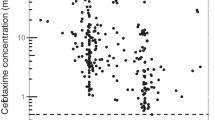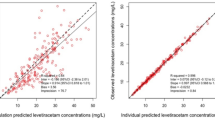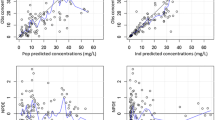Abstract
Thiopental was administered to neurosurgical patients for cerebral protection and its pharmacokinetic parameters were determined after a single bolus of 540, 1000 or 1500 mg (3 subjects) or after multiple doses of 250 mg (5 subjects) and 500 mg (2 subjects) every two hours for up to 7 days. The data were analysed by a two- or three- compartment model and linear kinetics. After a single IV bolus, the mean initial volume of distribution (V1) was 0.4811·kg−1, and the steady-state volume of distribution (Vss) was 2.16 1·kg−1. The distribution (t1/2α) and elimination (t1/2β) half-lives were 0.590 and 5.89 h, respectively, and the mean residence time (MRT) was 7.44 h. The clearance was 5.41 ml·min−1·kg−1. With repeated injections, the pharmacokinetic parameters for each patient were estimated taking into account all administered doses and blood samples, which were taken whenever possible daily at steady state and after the last dose. The variability observed in the pharmacokinetic parameters of thiopental reflected by the coefficient of variation (CV%) was wide but was of similar magnitude within patients (CVintra) as it was between patients (CVinter). The steady-state trough plasma concentration (Cmin obs) ranged from 4.8 to 30 mg·1−1 (mean 16.0 mg·1−1 and median 14.3 mg·1−1). Peak concentrations (Cmax obs) ranged from 8.35 to 45 mg·1−1 (25.4 mg·1−1, and median 23.3 mg·1−1). The values of V1 and Vss were similar to those obtained after a single dose. For V1, the mean was 0.333 1·kg−1. The mean Vss was 2.68 1·kg−1, with a CVintra of 12.6 to 56% and a CVinter of 13.2%. A shorter distribution half-life t1/2α was noted on multiple dosing; the mean value was 0.122 h. The elimination half-life t1/2β and the mean residence time became longer due to a decrease in clearance. For t1/2β the mean value was 16.3 h. The mean MRT was 21.9 h, CVintra 9.19 to 48.5%, and the CVinter 35.3%. The mean clearance was 2.16 ml·min−1·kg−1, CVintra 7.28 to 25.5%, and the CVinter 20.4%. This value is 50% lower than after a single dose.
Identification of the kinetic parameters of thiopental allows simulation of the effects of doses on subsequent plasma levels and will permit a priori prediction of day to day adjustment of drug dosage.
Similar content being viewed by others
References
Christensen JH, Andreasen F, Jansen JA (1981a) Influence of age and sex on the pharmacokinetics of thiopentone. Br J. Anaesth 53:1189–1195
Christensen JH, Andreasen F, Jansen JA (1982) Pharmacokinetics and pharmacodynamics of thiopentone: a comparison between young and elderly patients. Anaesthesia 37:398–404
Christensen JH, Andreasen F, Jansen JA (1983a) Thiopentone sensitivity in young and elderly women. Br J Anaesth 55:33–40
Homer TD, Stanski DR (1983) The effect of age on thiopental disposition. Anesthesiology 59:245
Jung D, Mayersohn M, Perrier D, Calkins J, Saunders R (1982a) Thiopental disposition as a function of age in female patients undergoing surgery. Anesthesiology 56:263–268
Sorbo S, Hudson RJ, Loomis J (1984) The pharmacokinetics of thiopental used in pediatric surgical patients. Anesthesiology 61:666–670
Christensen JH, Andreasen F, Jansen JA (1980) Pharmacokinetics of thiopentone in a group of young women and a group of young men. Br J Anaesth 52:913–918
Crankshaw DP, Edwards NE, Blackman GL, Boyd MD, Chan HNJ, Morgan DJ. (1985) Evaluation of infusion regimens for thiopentone as a primary anesthetic agent. Eur J Clin Pharmacol 28:543–552
Jung D, Mayersohn M, Perrier D, Calkins J, Saunders R (1982b) Thiopental disposition in lean and obese patients undergoing surgery. Anesthesiology 56:269–274
Christensen JH, Andreasen F, Jansen JA (1981b) Pharmacokinetics of thiopental in caesarian section. Acta Anaesth Scand 25:174–179
Morgan DJ, Blackman GL, Paull JD, Wolf LJ (1981b) Pharmacokinetics and plasma binding of thiopental. II.: Studies at Cesarean section. Anesthesiology 54:474–480
Andreasen F (1973) Protein binding of drugs in plasma from patients with acute renal failure. Acta Pharmacol Toxicol 32:417–429
Burch PG, Stanski DR (1982) Decreased protein binding and thiopental kinetics. Clin Pharmacol Ther 32:212–217
Christensen JH, Andreasen F, Jansen JA (1983b) Pharmacokinetics and pharmacodynamics of thiopental in patients undergoing renal transplantation. Acta Anaesth Scand 27: 513–518
Ghoneim MM, Pandya HB (1975) Plasma protein binding of thiopental in patients with impaired renal or hepatic function. Anesthesiology 42:545–549
Couderc E, Ferrier C, haberer JP, Henzel D, Duvaldestin P (1984) Thiopentone pharmacokinetics in patients with chronic alcoholism. Br J Anaesth 56:1393–1397
Pandele G, Chaux F, Salvadori C, Farinotti M, Duvaldestin P (1983) Thiopental pharmacokinetics in patients with cirrhosis. Anesthesiology 59:123–126
Airey IL, Smith PA, Stoddart JC (1982) Plasma and cerebrospinal fluid barbiturate levels during prolonged continuous thiopentone infusion. Anaesthesia 37:328–331
Cloyd JC, Wright BD, Perrier D (1979) Pharmacokinetic properties of thiopental in two patients treated for uncontrolable seizures. Epilepsia 20:313–318
Stanski DR, Mihm FG, Rosenthal MH, Kalman SM (1980) Pharmacokinetics of high-dose thiopental used in cerebral resuscitation. Anesthesiology 53:169–171
Taeger K, Murr R, Schmiedeck P, Jensen U, Peter K (1986) Thiopentalkinetik bei hochdosierter Anwendung. Anästh Intensivther Notfallmed 21:237–244
Turcant A, Delhumeau A, Premel-cabic A, Granry JC, Cottineau C, Six P, Allain P (1985) Thiopental pharmacokinetics under conditions of long-term infusion. Anesthesiology 63:50–54
Stanski DR, Burch PG, Harapat SH, Richards RK (1983) Pharmacokinetics and anesthetic potency of a thiopental isomer. J Pharm Sci 72:937–940
Sheiner LB (1981) Elsfit users manual. A technical report of the division of Clinical Pharmacology University of California, San Francisco
Gomeni C, Gomeni R, Siphar (1987) An integrated computer system for statistical and pharmacokinetic data analysis. 507–516. In Proceedings of the 7th International Congress of Medical Informatics, Europe. 87, Rome, September
Urien S (1993) Micropharm®: Analysis of Experimental Data in Pharmacology Binding, Kinetics & Others. Version 3.5, LOGINSERM.
Iliadis A (1988) Le logiciel Apis: adaptation de posologie, identification et simulation en pharmacocinétique clinique. Journées d'Informatique Médicale de Montpellier, Sauramps Médical, Inc. 100–111, Montpellier
Akaike A (1976) An information criterion (AIC). Math Sci 14:5–9
Gibaldi M, Perrier D (1982) Pharmacokinetics. In: Dekker M (ed) Drugs and the pharmaceutical sciences (2nd ed) Vol 15. New York, Basel
Morgan DJ, Blackman GL, Paull JD, Wolf LJ (1981a) Pharmacokinetics and plasma binding of thiopental. I.: Studies in surgical patients. Anesthesiology 54: 468–473
Ghoneim MM, Van Hamme MJ (1978) Pharmacokinetics of thiopentone: effects of enflurane and nitrous oxide anaesthesia and surgery. Br J Anaesth 50:1237–1242
Brodie BB (1952) Physiological disposition and chemical fate of thiobartiturates in the body. Fed Proc 11:632–639
Price HL, Kovnat PJ, Safer JN, Conner EH, Price ML (1960) The uptake of thiopental by body tissues and its relation to the duration of narcosis. Clin Pharmacol Ther 1:16–22
Shideman FE, Gould TC, Winters WD, Peterson RC, Wilner WK (1953) The distribution and in vivo rate of metabolism of thiopental. J Pharmacol Exp Ther 107:368–378
Dayton PG, Perel JM, Landrau MA, Brand L, Mark L (1967) The relationship between binding of thiopental to plasma and its distribution into adipose tissue in man, as measured by a spectrophotofluorometric method. Biochem Pharmacol 16:2321–2326
Brodie BB, Mark LC, Papper EM, Lief PA, Bernstein E, Rovenstine EA (1950) The fate of thiopental in man and a method for its estimation in biological material. J Pharmacol Exp Ther 98:85–96
Burch PG, Stanski DR (1983) The role of metabolism and protein binding in thiopental anesthesia. Anesthesiology 58:146–152
Mark LC, Brand L, Kamvyssi S, Britton RC, Perel JM, Landrau MA, Dayton PG (1965) Thiopental metabolism in human liver in vivo and in vitro. Nature 206:1117–1119
Russo H, Audran M, Bressolle F, Bies J, Maillols H (1993) Displacement of thiopental from human serum albumin by associated drugs. J Pharm Sci 82:493–497
Author information
Authors and Affiliations
Rights and permissions
About this article
Cite this article
Russo, H., Brès, J., Duboin, M.P. et al. Pharmacokinetics of thiopental after single and multiple intravenous doses in critical care patients. Eur J Clin Pharmacol 49, 127–137 (1995). https://doi.org/10.1007/BF00192371
Received:
Accepted:
Issue Date:
DOI: https://doi.org/10.1007/BF00192371




